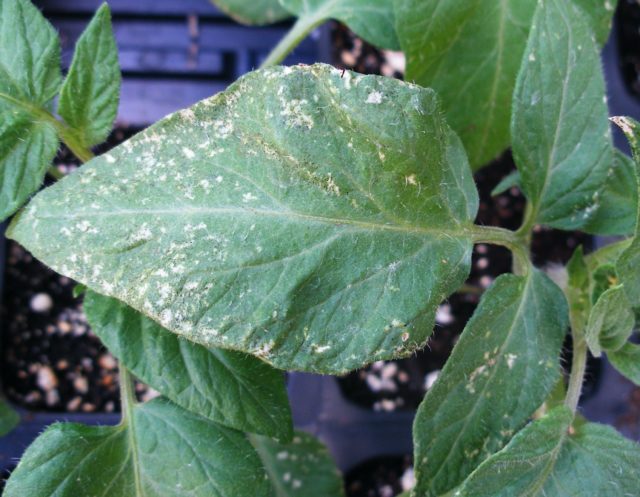In this series of articles, Growers Network talks about a few of the most common Cannabis pests you need to watch out for. Today’s topic: Thrips

Thrips are sap-sucking insects that get their nutrition by chewing on plant leaves and slurping up the juice. The name is fun to say, but the insect is not fun for anybody who’s growing. Let’s dive into thrips, and how to prevent them and treat them.
Quick Look
- Common Name: Thrips
- Scientific Name: Insects of the order Thysanoptera. The majority of thrip pests come from the family Thripidae.
- Symptoms: Silver dots and lines on leaves, leaf damage, infection by other plant diseases
- Timing: Any time
Thrips

Thrips are tiny, but not microscopic, sap-sucking insects that will happily infest a variety of plants, including cannabis. They are about the width of a sewing needle, and only about as long as the needle point. They are most easily observed with a jeweler’s loupe, but you can spot these guys with your bare hands if you know what you’re looking for.

While thrips are annoying, their true danger isn’t from the direct damage they do to your leaves. The true danger lies in their ability to transmit plant diseases and cause other problems. Unlike aphids, which tend to find a target plant and sit there as long as possible, thrips are relatively mobile, taking the juice from your plants wherever they please. Again, unlike aphids, which are usually host-specific, thrips can occupy a wide variety of host plants (and even fungal hosts!), thus enabling the spread of other diseases. Additionally, some thrips are known to create plant galls, which are essentially plant warts. We don’t want our plants to have herpes, so we don’t want thrips on our cannabis.
Thrips can reproduce asexually, meaning that if even one gets into your grow operation, the problem could become exponential. Vigilance is key!
Editor’s Note: Some thrips have an important ecological role in pollination and others prey on mites, but most thrips involved with cannabis are not helpful.
Prevention
Prevention starts with you!

The first and most important part of prevention is spotting thrips before they become a problem. Because thrips are very small and sometimes camouflaged, it may be difficult to spot one without a jeweler’s loupe. One resource we looked at recommend taking a leaf from a plant you’re inspecting, and shaking it on a piece of white paper. This contrast would make the thrip stand out.
Regardless of whether you can spot the little insects, you should be able to identify the damage they do to your leaves. They leave irregular silver-white or yellow blotches and spots on your plants’ leaves, and you may sometimes observe a plant becoming infected with a transmittable plant disease.

Preventing thrips is relatively simple, and there are a few preventative measures you can take that have proven effective:
- Sticky traps are very effective at catching thrips.
- Predatory mites will target thrip eggs and larvae, rendering thrips’ attempts to reproduce fruitless.
- Neem oil and other insecticidal oils will interfere with thrips’ feeding, killing them.
- Diatomaceous Earth shows some efficacy against thrips.
- Positive pressure in a growing facility or greenhouse should help keep thrips out.
You may want to quarantine your plants if they have thrips, but be careful when moving the plants. Thrips can be easily knocked off of infected plants, and due to their mobile nature, they may simply hop onto the next plant.
Treatment
Treatment of an infestation will continue similarly to prevention methods, but more extreme measures may be required if the infestation is particularly bad. Generally, treatment of a thrips infestation will require an insecticidal spray or application of insecticidal oil. If the infestation is really bad, quarantine and slash-and-burn methods may be necessary. Again, thrips are easily knocked off of their host plant, so don’t move the plants too vigorously if you choose to quarantine.
Conclusion
Well, there you have it -- thrips. Annoying, tiny little insects that can cause a heap of trouble if you don’t take care to prevent them. By themselves, they may not be the worst thing ever, but enough of them can cause a problem.
10 Best Gift Ideas for Cannabis Connoisseurs and Growing Aficionados (2022)
December 7, 2022Developing and Optimizing a Cannabis Cultivation System
December 14, 2021Dealing with Insomnia: How Can CBD Help?
December 10, 2020Your Guide to Sleep and CBD
December 7, 2020
Do you want to receive the next Grower's Spotlight as soon as it's available? Sign up below!

Do you have any questions or comments?

About the Author
Hunter Wilson is a community builder with Growers Network. He graduated from the University of Arizona in 2011 with a Masters in Teaching and in 2007 with a Bachelors in Biology.